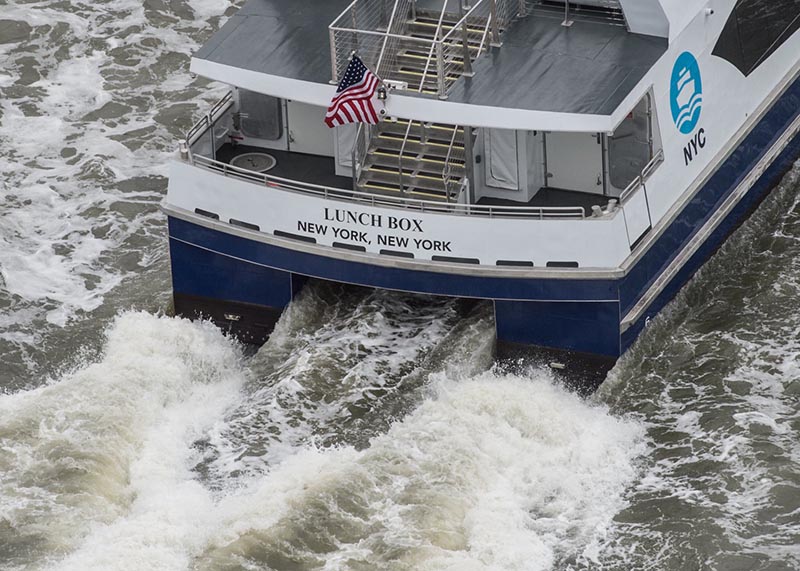After a tumultuous spring startup and ridership numbers that surprised its most ardent backers, the NYC Ferry public system is moving into a fall commuting season with some reasons for optimism.
Despite a spring and summer season marred by customer complaints about delays and crowded boats, the city Economic Development Corporation and ferry operators HNY Ferry Fleet LLC touted a consumer survey that showed patronage building for the new service.
Mayor Bill de Blasio proposed the NYC Ferry as a better commuting option for residents in underserved neighborhoods, and a step toward waterfront revitalization. With the first 149-passenger boats arriving in April, the city moved up the start date to May 1 for the Rockaway route.
The new boats were wildly popular, during a summer marked by rail and subway breakdowns. Two weeks into May, Terry MacRae, CEO of HNY’s parent company Hornblower Cruises and Events, said the Rockaway run was already running at nearly twice the anticipated ridership.
As more routes opened in June, riders soon complained of delays, long lines and crowded boats, especially on weekends. They vented on social media like Twitter — and NYC Ferry engaged with the complaints, through its own Twitter and Facebook accounts, acknowledging problems and assuring that action was being taken.
“Social media is a great place for folks to share feedback, which is usually not positive,” said Cameron Clark, a Hornblower vice president and manager of New York operations. But NYC Ferry’s engagement with riders, and its learning curve with managing the network, has paid off, according to customer surveys, said Clark.
With results from a survey of over 1,300 riders, the Economic Development Corporation generated a net promoter score — a measure of how likely riders were to be detractors of the ferry, compared to those with a positive view who would recommend it to other people.
NYC Ferry came out with an NPS score of 71, comparable to airline JetBlue at 68, and higher than the ridesharing service Uber at 30, said Clark.
There is some seasonality to ferry ridership, but even during the summer tourist season “87% of the riders were New Yorkers,” said Clark. Those numbers showed patronage building, with 53% of peak time riders using the ferry regularly.
“Heading into the winter I think we’re going to see strong commuter ridership,” he said.
To add summer capacity two 400-passenger vessels were leased from the private commuter ferry company New York Waterway, and city officials announced plans to build larger vessels for 2018, in addition to the 16 now in service.
Three of those new 97’x28’ Incat Crowther-designed Subchapter K boats, dubbed the Rockaway class, will be powered by twin 12-cylinder, 1,400-hp Baudouin12M26.3 diesel engines, coupled to ZF Marine ZF3050 gearboxes, and turning custom 5-bladed Michigan Wheel propellers, for a service speed of 24 knots.
Those boats are now under construction at Metal Shark, Franklin, La., which delivered six of the original 149-passenger class. Horizon Shipbuilding, Bayou La Batre, Ala., which built 10 for the fleet, announced in September that it had suffered a revenue shortfall from the New York contract and was “reorganizing” all its projects as a result.
Meanwhile, utilities and infrastructure are going into the new ferry homeport in Brooklyn, and with 200-plus crew hired NYC Ferry is probably two-thirds of the way toward building its full workforce, said Cameron.
Customer complaints persist, as do critics’ assertion that the EDC and Hornblower should have foreseen the strong public response for ferry service with a $2.75 fare — subsidized for the same ticket price as the city subway.
Clark said Hornblower is “working on the data science side” to optimize best use of boats and scheduling – part of the big data that operators are collecting through the NYC smartphone ticketing app.
The first-year problems have to be viewed in the context of the city’s ambition, “when you see an expansion of this magnitude, when ferries haven’t been expanded like this in a century,” said Clark. The decision to start with a flexible fleet of 149-passenger vessels, interchangeable on the six planned routes, was reasonable, he said: “We have to be responsible with the taxpayers’ money.”
One upside of the big crowds: More riders paying into the system, and ultimately reducing the per-rider city subsidy. The 2017 figures will likely come in below the $6.56 per ride originally projected — and less than subsidies for the Long Island Rail Road, said Clark.




